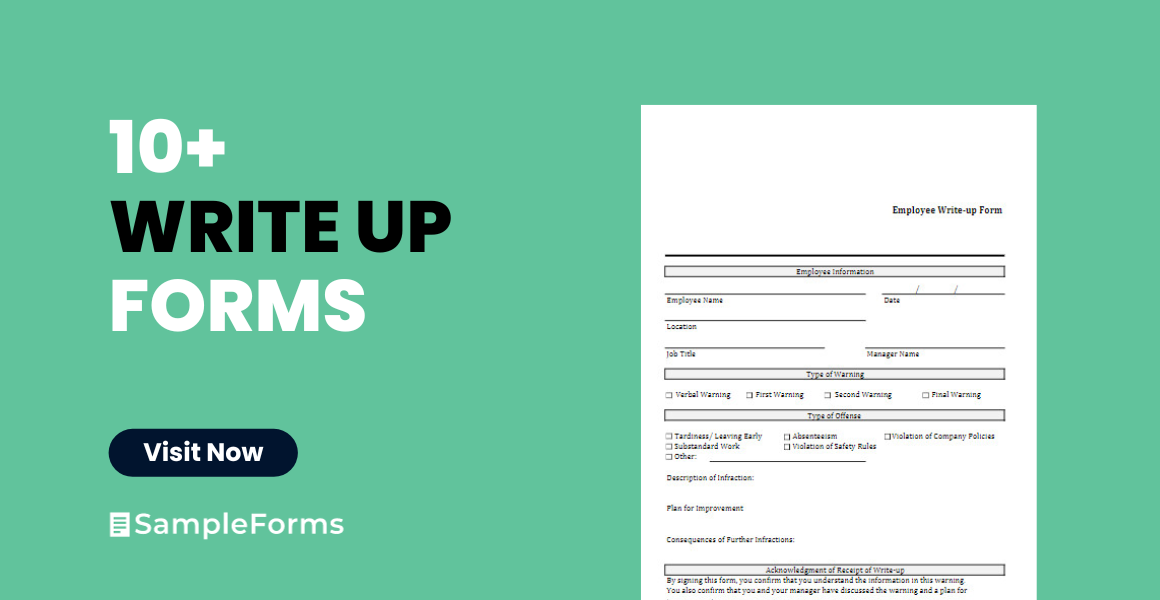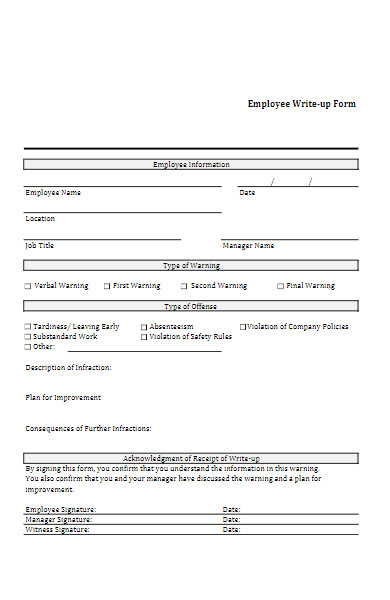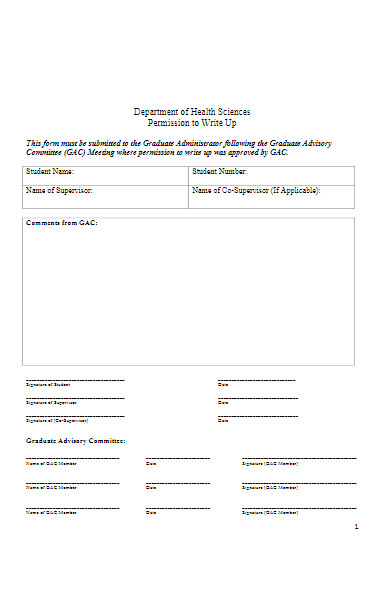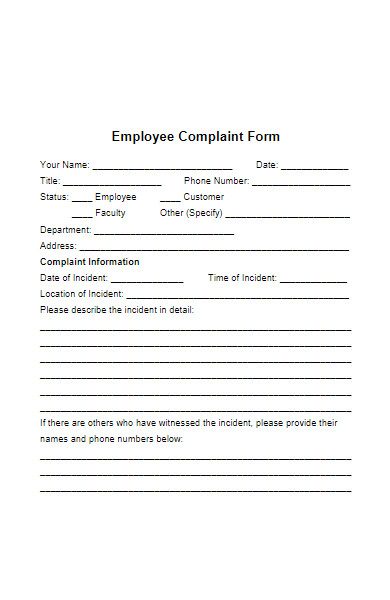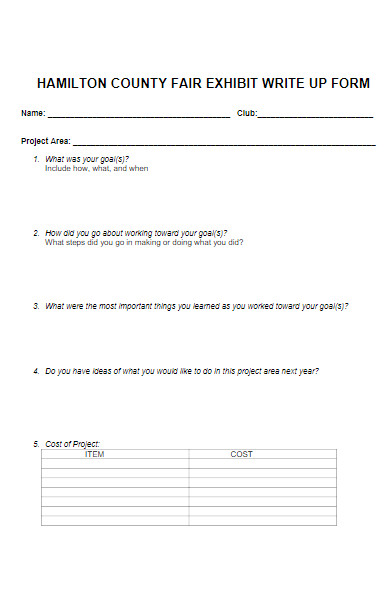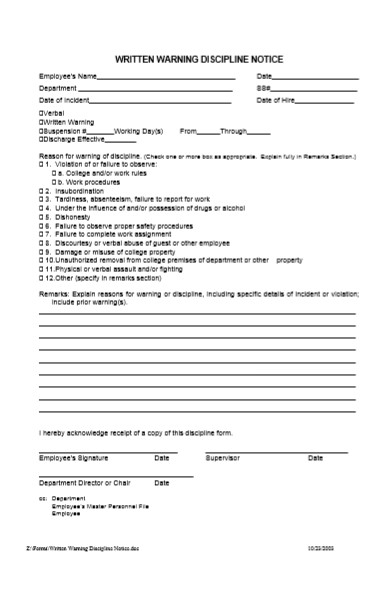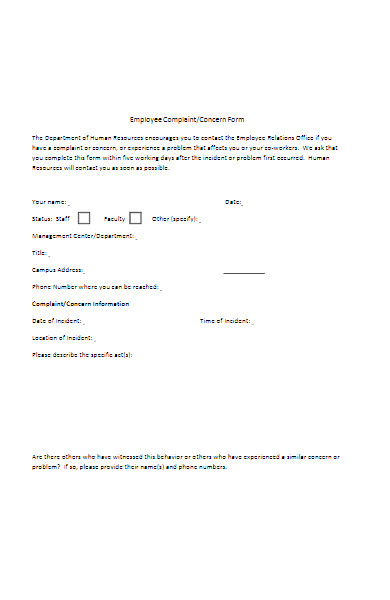A Write Up Form is an essential tool in the organizational toolkit, often employed to document employee performance issues or infractions. Acting as a record of incidents, it promotes clarity between management and staff. These printable form can vary in type, from documenting behavioral concerns to recording tardiness. With real-life examples, insights on crafting them effectively, and practical tips, we’ll delve deep into the world of Write Up Forms, ensuring you understand their significance and the nuances of their use.
What is a Write Up Form ? – Definition
A Write Up Form is a formal document used by employers and management to record incidents of employee misconduct, performance issues, or policy violations within an organization. This form serves as a written record of an individual’s behavior or performance, providing evidence of feedback form and any corrective actions suggested or taken. It ensures transparency and accountability, facilitating clear communication between the employee and the management regarding expectations and areas of improvement.
What is the Meaning of a Write Up Form?
A write-up form typically refers to a document used in professional settings, especially in workplaces, to formally document a performance issue or policy violation by an employee. It’s a way for management to keep a record of an employee’s behavior or performance challenges. Here are some key components and purposes of a write-up form:
- Employee Information: This section captures basic information like the employee’s name, job title, and department.
- Incident Details: The form will typically have a space for detailing the specific incident or behavior that led to the write-up. This may include the date, time, location, and a detailed description of the incident.
- Policy Violation: If the employee’s behavior violated a specific company policy, the form might have a section that allows the manager to indicate which policy was violated.
- Previous Warnings: This section allows the manager to note if the employee has been warned or written up for similar behavior in the past.
- Corrective Action: The form might include recommendations or mandates for corrective action, such as attending a training, making amends with another employee, or other relevant actions.
- Employee Response: Some write-up forms offer a space for the employee to provide their perspective on the incident or to acknowledge the information.
- Signatures: Typically, both the manager (or the person issuing the write-up) and the employee are required to sign the form. The employee’s signature doesn’t necessarily mean they agree with the content but that they’ve received and reviewed the write-up.
- Consequences: The form may also outline potential consequences if the behavior continues or if further policy violations occur. This can range from further disciplinary actions to termination.
The primary purposes of a write-up form are:
- Documentation: To provide a written record of the incident or behavior.
- Accountability: To make sure the employee is aware of the issue and the potential consequences.
- Improvement: To guide the employee towards correcting the behavior or addressing performance issues.
- Protection: For employers, having a record of disciplinary actions can be vital in situations where an employee claims wrongful termination or discrimination.
It’s important for employers to be consistent and fair in how they use write-up forms and to ensure that they’re following local labor laws and regulations.
What is the Best Sample Write Up Form?
Company Name: Department:
Employee Information:
- Name: __________________________
- Job Title: __________________________
- Date of Hire: __________________________
- Supervisor: __________________________
Incident Details:
- Date of Incident: __________________________
- Time: __________________________
- Location: __________________________
Description of Incident/Policy Violation: (Provide specific details, include witnesses if any, and attach any additional documentation or evidence if necessary.)
Previous Warnings/Incidents (if applicable):
- Date: ___________ Description: ________________________________________________
- Date: ___________ Description: ________________________________________________
- Date: ___________ Description: ________________________________________________
Corrective Actions Recommended:
Potential Consequences for Further Violations or Non-compliance:
Employee Comments/Response: (Employee may provide their perspective on the incident.)
Acknowledgment of Documentation:
I, __________________________ (employee name), acknowledge that I have been informed of this write-up and understand its contents. My signature does not necessarily indicate agreement with the content but confirms that I have reviewed this documentation with my supervisor.
Employee Signature: __________________________ Date: ___________
Supervisor Signature: __________________________ Date: ___________
Notes/Additional Comments:
This sample form can be adjusted based on the specific needs of a company or organization. However, always ensure that any form or procedure adheres to local labor laws and guidelines. It’s also advisable to consult with a legal expert or HR professional when creating or updating such forms. You should also take a look at our sample employee write up form.
FREE 10+ Write Up Forms
What is a Write Up Form used for in HR?
A Write Up Form in HR (Human Resources) is used to formally document and address performance issues, behavioral incidents, or policy violations by an employee. Here’s a breakdown of its primary purposes:
- Documentation: The form provides a written record of the incident or behavior. This can be critical if there are recurring issues, or if there’s a need to show a history of attempts to correct an employee’s behavior or performance.
- Communication: It serves as a formal method of communicating with the employee about specific concerns. The form highlights what the problem was, any policies that were violated, and often the expected corrective actions.
- Consistency: By using standardized forms, HR ensures that similar incidents are treated in a consistent manner across the organization. This can help reduce claims of favoritism or discrimination.
- Employee Accountability: By acknowledging the write-up (usually through signing the form), the employee becomes aware of the issue and the potential consequences if the behavior continues.
- Guidance for Improvement: The form can provide feedback and recommended actions for the employee to correct the behavior or improve performance.
- Protection for the Company: In cases where employment termination becomes necessary, having a documented history of write-ups can support the company’s decision, especially if there are legal challenges. The documentation can show that the company took steps to address the issue and provided the employee with opportunities to improve.
- Review and Evaluations: These forms can be used as references during performance evaluations to review any challenges and improvements over a period.
In essence, a Write Up Form is a tool that helps HR and management maintain a professional and consistent approach to handling workplace issues while ensuring that employees are given clear feedback and an opportunity to improve. Our restaurant employee write-up forms is also worth a look at
How to fill out a Write Up Form properly?
Filling out a Write Up Form properly is crucial to ensure clarity, fairness, and legal compliance. Here’s a step-by-step guide on how to do so:
-
Employee Information:
- Name: Clearly write the full name of the employee.
- Job Title: Specify the employee’s current position.
- Department: Mention the department where the employee works.
- Date of Hire: This can provide context, especially if the employee is new and might not be fully aware of all policies.
-
Incident Details:
- Date and Time: Clearly indicate when the incident or violation occurred.
- Location: Specify where it happened, such as “break room” or “warehouse.”
- Description: Detail the incident, violation, or performance issue. Be specific and objective. Avoid using overly negative or inflammatory language. If there were witnesses, consider noting their names.
-
Policy Violation:
- If the behavior or incident is a direct violation of a company policy, reference the specific policy or section from the employee handbook.
-
Previous Warnings:
- If this isn’t the first incident, note previous warnings or write-ups related to this behavior. This can provide context and show a pattern if one exists.
-
Corrective Action:
- Specify any immediate actions taken (e.g., sending the employee home for the day).
- Outline recommended or required actions for the employee to remedy the situation, such as attending training, apologizing to a colleague, etc.
-
Potential Consequences:
- Clearly state the repercussions if the behavior continues or if there’s another policy violation. This can range from additional write-ups to termination.
-
Employee Comments:
- Leave a space for the employee to provide their perspective. They might agree, disagree, or offer additional information about the incident.
-
Signatures:
- The employee and the supervisor (or the person issuing the write-up) should sign and date the form. Make sure to inform the employee that signing doesn’t necessarily mean they agree with the write-up, but that they acknowledge receiving and understanding it.
-
Notes/Additional Comments:
- Any further observations, contextual information, or clarifications can be added here.
-
Attachments:
- If there are any supporting documents, like emails, photos, or statements from witnesses, attach them to the form or make a note that they are available upon request.
Remember:
- Be objective and fair: Stick to the facts and avoid letting personal emotions or biases influence the write-up.
- Always consult the company’s policies or employee handbook to ensure consistency and fairness.
- It’s advisable to review the write-up with HR or a legal expert before finalizing, especially in complex or sensitive situations.
- Store the completed form securely, respecting confidentiality and privacy regulations.
Can an employee refuse to sign a Write Up Form?
Yes, an employee can refuse to sign a Write Up Form. However, there are some implications and considerations to keep in mind:
- Acknowledgment, Not Agreement: It’s essential to clarify that the employee’s signature on a Write Up Form is not an admission of guilt or agreement with its content. Instead, it’s an acknowledgment that they have received and reviewed the form. This distinction can sometimes alleviate an employee’s hesitation to sign.
- Document the Refusal: If an employee chooses not to sign, the supervisor or HR representative should note the refusal on the form. This could be a simple statement such as “Employee declined to sign on [date].” This serves as a record that the employee was presented with the write-up, even if they didn’t sign it.
- Witnesses: If possible, have a third party (such as another manager or an HR representative) present during the discussion. If the employee refuses to sign, the witness can attest that the employee was indeed presented with the form and chose not to sign it.
- Employee Statement: Offer the employee the opportunity to provide a written statement or response if they disagree with the content of the write-up. This allows for a balanced record of the event or behavior in question.
- Policy Review: Companies should have a clear policy about the process and implications of not signing a write-up. This policy should be communicated to employees to prevent misunderstandings.
- Legal Implications: In some jurisdictions, the refusal to sign a document can have legal implications, especially if employment termination or disciplinary actions are considered based on the write-up. Employers should be aware of local labor laws and, if in doubt, consult with legal counsel.
It’s also essential for management and HR to approach such situations with understanding and professionalism. An employee’s refusal to sign might indicate deeper issues, such as workplace dynamics, communication breakdowns, or perceptions of unfair treatment. Engaging in a constructive dialogue can help address the root causes and improve the working environment. In addition, you should review our Employee Write-Up Forms.
What to do if you disagree with a Write Up Form?
If you’re an employee and you disagree with a Write Up Form you’ve received, taking measured and professional steps can help address the situation. Here’s what you can do:
- Stay Calm and Professional: Your immediate reaction might be emotional, especially if you feel the write-up is unjust. However, it’s essential to stay calm and avoid confrontational behavior, which could exacerbate the situation.
- Review the Document Carefully: Before responding, read through the entire form to understand the specifics of the allegations or issues raised. This will help you craft a more informed response.
- Seek Clarification: If there are parts of the write-up you don’t understand or if you need more context, ask your supervisor or HR representative for clarification.
- Document Your Perspective: Prepare a written response or statement detailing your perspective on the incident or issue. Be specific, use facts, and avoid making personal attacks. If there are witnesses or supporting documents that can corroborate your side of the story, mention them.
- Request a Meeting: Arrange a time to discuss the write-up with your supervisor and, if necessary, an HR representative. This meeting provides an opportunity for both sides to share their views and work towards a resolution.
- Listen Actively: During discussions, listen to the concerns raised without interrupting. Understanding the other party’s perspective can help find common ground.
- Seek Mediation: If direct discussions don’t resolve the issue, consider seeking mediation. Some companies offer internal mediation services, or you can look for an external mediator to facilitate the conversation.
- Consult Company Policy: Familiarize yourself with your company’s policies on disciplinary actions and grievance procedures. This will give you an understanding of your rights and the proper channels to address disagreements.
- Keep Records: Document all interactions related to the write-up, including meetings, conversations, and written communications. This can be helpful if there are further disputes or actions.
- Seek Legal Counsel: If you believe the write-up is a result of discrimination, retaliation, or any other unlawful action, you might want to consult with an attorney to understand your rights and potential courses of action.
- Consider Your Options: If disagreements with management become a pattern, or if you feel the work environment is no longer conducive to your well-being or growth, you might need to consider whether it’s in your best interest to remain with the company.
Remember, while it’s essential to stand up for your rights, always approach disagreements in a constructive and professional manner. This not only helps resolve the immediate issue but also preserves your reputation and relationships in the workplace. You may also be interested in our sample Written Warning Form.
How long should you keep an employee Write Up Form on file?
The length of time an employer should keep an employee Write Up Form on file depends on several factors, including company policies, the nature of the write-up, legal requirements, and best practices in HR record-keeping. Here’s a general overview:
- Company Policies: Many companies have specific policies regarding the retention of employee disciplinary records. These policies often dictate how long write-ups and other related documents should be kept on file.
- Nature of the Write-Up: Minor infractions might not be retained as long as more severe or recurring issues. For example, a write-up for being tardy might be removed from an employee’s file after a year without further incidents, while a write-up for a more serious violation like harassment might be kept for several years.
- Legal Requirements: Different jurisdictions have various laws regarding the retention of employment records. For instance, in the U.S., certain records related to employment decisions (which can include disciplinary actions) should be kept for at least one year under Equal Employment Opportunity Commission (EEOC) guidelines. However, depending on the state and the nature of the records, some documents might need to be retained for longer.
- Potential Litigation: If there’s potential for litigation or if an employee has filed a complaint with a regulatory agency, all relevant records, including write-ups, should be retained until the matter is fully resolved.
- Best Practices: Generally, HR best practices suggest retaining disciplinary records for at least one to three years after the date of the incident or the employee’s termination date. This period allows for adequate documentation if patterns of behavior emerge or if reference is needed for performance evaluations.
- Expungement: Some companies have policies where write-ups or disciplinary actions are “expunged” or removed from an employee’s record after a certain period, especially if the employee shows improvement or if the issue was minor. This practice can be beneficial for morale and trust, as it demonstrates that employees can move past mistakes.
- Confidentiality and Security: Regardless of the retention period, it’s crucial to ensure that all employee records, including write-ups, are stored securely and can only be accessed by authorized personnel. This protects both the employee’s privacy and the company’s sensitive information.
Lastly, always consult with HR professionals or legal counsel to ensure that record retention practices align with current laws and regulations specific to your jurisdiction and industry. You may also be interested to browse through our other work warning forms and Sample Employee Forms.
Are Write Up Forms legally binding?
Write Up Forms themselves are not legally binding contracts in the same way that an employment agreement or other contractual document would be. However, they do have legal significance in several contexts:
- Documentation: Write Up Forms provide a record of an employee’s behavior or performance issues and the employer’s attempts to address and correct them. This documentation can be crucial if there’s ever a dispute about the circumstances leading up to disciplinary actions, including termination.
- Protection in Legal Disputes: If an employee challenges a disciplinary action or termination – for instance, alleging wrongful termination or discrimination – the Write Up Forms can be used as evidence to demonstrate that the employer had legitimate, non-discriminatory reasons for the action taken.
- Consistency and Fairness: Regular use of Write Up Forms can help ensure consistency in how employee issues are addressed. This can help protect employers from claims of favoritism, discrimination, or unequal treatment.
- Acknowledgment of Receipt: While the employee’s signature on a Write Up Form doesn’t typically mean they agree with its contents, it usually acknowledges that they’ve received and understood the write-up. This acknowledgment can be significant if there’s a claim later on that the employee was not informed of performance or behavior issues.
- Local Laws and Regulations: The weight and significance of a Write Up Form can vary depending on local employment laws and regulations. In some jurisdictions, for instance, certain procedures might need to be followed for a write-up to be considered in disciplinary actions.
While Write Up Forms have legal implications, it’s important to remember that they are primarily tools for communication and documentation within the employer-employee relationship. Employers should always consult with legal counsel or HR professionals to ensure that their disciplinary procedures, including the use of Write Up Forms, comply with local laws and best practices.
What information is essential on a Write Up Form?
A Write Up Form should be comprehensive yet concise to effectively communicate and document performance issues, behavioral incidents, or policy violations by an employee. Essential information typically included on such a form consists of:
-
Employee Information:
- Full Name: The complete name of the employee being written up.
- Job Title: The current position or role of the employee.
- Department: The department or team where the employee works.
- Employee ID: If applicable, the identification number assigned to the employee.
- Date of Hire: The date when the employee started working with the company.
-
Incident Details:
- Date and Time: Clearly specify when the incident or violation took place.
- Location: Indicate where the incident occurred.
- Description: A detailed, objective account of the incident, behavior, or performance issue. This should be specific and avoid vague or subjective language.
-
Policy or Rule Violation:
- Mention any company policies, rules, or procedures that were violated. Reference specific sections or clauses from employee handbooks or guidelines if possible.
-
Previous Warnings or Incidents:
- Detail any prior warnings, write-ups, or related incidents that have been given to the employee about similar issues.
-
Corrective Action or Consequences:
- Outline the immediate actions taken or recommended steps for the employee to address the issue.
- State the potential consequences if the behavior continues or if there’s another violation.
-
Manager/Supervisor Information:
- Name: The person issuing the write-up.
- Title: The position of the person issuing the write-up.
- Date: The date when the form is completed.
-
Employee Comments:
- A space for the employee to provide feedback, explanations, or any additional context about the incident.
-
Signatures:
- Spaces for both the employee and the supervisor/manager to sign, along with the date of signing. The employee’s signature usually indicates acknowledgment of receipt rather than agreement with the content.
-
Additional Notes or Comments:
- Any further information, observations, or contextual details that could be relevant.
-
Attachments or Supporting Documents:
- Indicate if there are any additional documents, such as emails, witness statements, or photos, attached or available upon request.
It’s important to ensure that Write Up Forms are consistent, fair, and aligned with company policies and legal regulations. Periodic reviews and updates to the form might be necessary to ensure it remains effective and compliant with evolving workplace norms and regulations. In addition, you should review our Written reprimand forms.
How to Create a Write Up Form?
Creating a Write Up Form involves understanding the essential components that make it effective and compliant with workplace policies and legal standards. Here’s a step-by-step guide to creating one:
1. Understand the Purpose:
- Identify the primary use cases for the form, whether they be for behavioral issues, performance concerns, or policy violations.
2. Choose a Clear Format:
- Decide whether you want a digital form (e.g., a fillable PDF or an online form) or a paper-based form.
- Use a clear and organized layout, with distinct sections for ease of use.
3. Header:
- Begin with a title such as “Employee Write Up Form” or “Employee Disciplinary Action Form.”
- You might also want to include the company logo or name at the top.
4. Employee Information Section:
- Include fields for the employee’s full name, job title, department, employee ID, and date of hire.
5. Incident Details:
- Fields for the date, time, and location of the incident.
- Provide a large enough space for a detailed description of the incident or violation.
6. Policy or Rule Violation:
- Have a section where specific policies or rules that were violated can be referenced.
7. Previous Warnings:
- Provide space to detail any previous warnings or incidents related to the current issue.
8. Corrective Action:
- Specify any actions the employee should take or any consequences resulting from the incident.
9. Employee Comments Section:
- Reserve a space for the employee to write comments, explanations, or clarifications.
10. Signatures:
- Include spaces for the date, employee signature, and manager/supervisor signature. Remember to clarify that the employee’s signature denotes acknowledgment, not necessarily agreement.
11. Additional Notes or Attachments:
- Indicate if there are any supporting documents or additional information.
12. Review and Refine:
- Once you’ve drafted the form, review it for clarity and completeness.
- Consider having it reviewed by HR professionals and possibly legal counsel to ensure it’s compliant with workplace laws and regulations.
13. Pilot the Form:
- Before officially rolling it out, test the form with a few managers or supervisors to get feedback and make any necessary tweaks.
14. Training:
- Ensure that managers and HR staff understand how to fill out the form correctly and know when it’s appropriate to use it.
15. Review Periodically:
- Regularly review and update the form to accommodate changes in company policies or legal requirements.
16. Storage and Confidentiality:
- Establish a secure method for storing completed forms, ensuring they remain confidential and only accessible to authorized personnel.
Remember, while the form itself is a valuable tool, the conversations that accompany its use are equally important. Managers and supervisors should be trained not only on how to complete the fillable form but also on how to conduct constructive discussions with employees about the issues being addressed.
Tips for creating an Effective Write Up Form
An effective Write Up Form should provide clarity, consistency, and fairness while properly documenting employee infractions or performance concerns. Here are some tips to ensure your Write Up Form is effective:
- Keep it Simple and Clear: Use straightforward language and avoid overly technical or legalistic terms. Each section should have a clear purpose and be easy to understand.
- Be Objective: Focus on facts rather than subjective opinions. Describe incidents or behaviors specifically, without adding personal judgments.
- Standardize the Process: Consistency is key. Everyone in the organization should use the same form and follow the same process, ensuring uniform treatment of all employees.
- Space for Details: Ensure there’s adequate space for managers to detail the incident or concern. This can be crucial if the write-up is ever reviewed or challenged.
- Employee Feedback Section: Always include a section for employees to share their perspective or provide additional context. This can help avoid misunderstandings and can be vital in cases of disputes.
- Confidentiality: Highlight the confidential nature of the form to ensure that both the manager and the employee understand the sensitivity of the information.
- Reference Company Policies: Clearly link any violations or concerns to specific company policies, rules, or performance standards. This helps ensure fairness and that employees understand what’s expected of them.
- Provide Guidance on Consequences: Specify potential consequences if the behavior or issue persists. This sets clear expectations for the employee.
- Digital Options: Consider digital or online versions of the form, which can offer advantages like easier storage, retrieval, and tracking.
- Regularly Review and Update: Periodically revisit the form to ensure it remains current with company policies, best practices, and legal requirements.
- Training: Train supervisors and managers on how to use the form correctly, emphasizing the importance of objectivity, fairness, and constructive feedback.
- Follow Up Actions: Outline any recommended or required follow-up actions, such as additional training, counseling, or performance reviews.
- Clarity on Signatures: Make sure employees understand that their signature typically indicates acknowledgment of receiving the form, not necessarily agreement with its content.
- Avoid Ambiguities: Make sure there’s no room for misinterpretation. Each section and instruction should be as clear as possible.
- Attachments or Supporting Documents: Clearly indicate if there are any additional documents related to the incident. This ensures a comprehensive view of the situation.
- Encourage Face-to-Face Conversations: While the form is a documentation tool, it should complement, not replace, face-to-face discussions about the issue. Encourage managers to use the form as a starting point for constructive dialogue.
Remember, the ultimate goal of a Write Up Form is not just to document issues but to foster understanding, encourage improvement, and ensure a productive and harmonious work environment. The form should be a tool that supports these objectives.
A Write Up Form is a formal HR document used to record employee infractions or performance concerns. It serves as a communication tool between employers and employees, ensuring clarity and consistency in addressing issues. These forms can vary in format but typically include incident details, violated policies, and corrective actions. Proper creation and usage promote fairness, transparency, and constructive feedback in the workplace. You should also take a look at our Sample Pre-Appraisal Forms.
Related Posts Here
-
Service Agreement Form
-
Income Statement Form
-
Accident Statement Form
-
Performance Review Form
-
Event Contract Form
-
Contest Registration Form
-
Waiting List Form
-
Restaurant Schedule Form
-
Mobile Home Bill of Sale
-
Landlord Consent Form
-
60-Day Notice to Vacate Form
-
Financial Statement Form
-
Product Evaluation Form
-
Construction Contract
-
School Receipt Form
